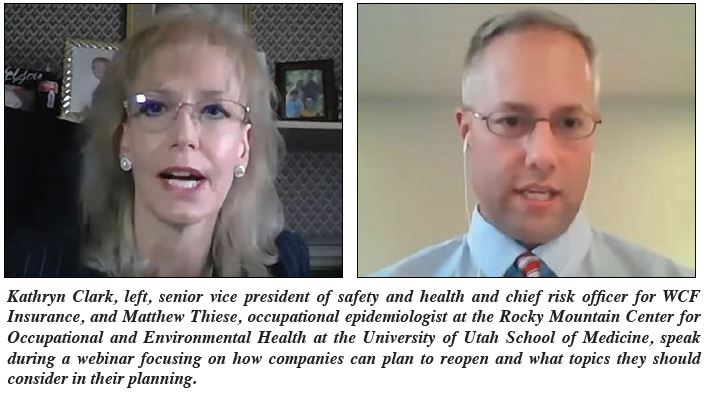By Brice Wallace
As Utah moves toward reopening businesses that were closed because of COVID-19, a few speakers during a recent webinar had a few broad suggestions for those companies.
Make plans. Make those plans industry- and company-specific. Be nimble because those plans will change. Consider everything needed to provide a safe workplace for employees and customers.
“I know people are anxious to get back to work. Business are anxious to get back to prosperity. It’s important that we do it safely,” said Kathryn Clark, senior vice president of safety and health and chief risk officer for WCF Insurance.
Her comments came during the “Creating a Safe and Healthy Work Environment” webinar, presented by the Salt Lake Chamber, the University of Utah Rocky Mountain Center for Occupational & Environmental Health and WCF Insurance.
The webinar featured tips, tools and models for businesses to reopen in a safe and healthy way. But a rule of an epidemic is that “a day is an eternity,” according to Dr. Kurt Hegmann, chief of the Division of Occupational and Environmental Health and director of the Rocky Mountain Center for Occupational and Environmental Health.
“This is something which small-business owners are going to actually be better prepared to understand than the large ones,” Hegmann said. “A small-business owner is typically encountering various problems that they need to solve on the fly, every day, whether it is a delayed delivery or production problem or so forth. In a larger organization, that’s not typically handled in the C-suite.
“So, a small-business owner can better, I think, understand the issue of taking your best shot at it, making a decision and when the facts change you take another swing at it, and moving on.”
Speakers cautioned that reopening businesses will be more of a dial than a switch, with gradual changes required on the path to a “new normal.”
Matthew Thiese, occupational epidemiologist at the Rocky Mountain Center for Occupational and Environmental Health at the University of Utah School of Medicine, said “it makes a lot of sense” for the first businesses to open to be ones where wide spacing is readily available to accommodate physical distancing.
Elements for reopening companies to consider are providing surveillance and training for employees, helping them understand virus symptoms, incorporating appropriate hygiene, wearing masks and maintaining social distancing,
“It’s not a one-size-fits-all situation,” Thiese said. “It’s definitely industry-specific as well as location-specific — thinking about how in your business or in your industry these types of practices of distancing and wearing masks or maybe sharing shifts or that type of stuff and disinfecting, can play a role in this.
“What we’re doing at the Rocky Mountain Center won’t work at some other places. Really, [be] considering your own company-specific situation and then looking through the bigger lens of the fact that what you say or what you do right now may be very different in a week or a couple of weeks.”
Hegmann encouraged companies to involve employees in the planning. “After all, nobody’s got a monopoly on knowledge here,” he said. “There’s no doubt that some of our employees are going to come along with the best idea.”
At WCF Insurance, most employees have been telecommuting. Meetings have taken place through Zoom and Teams. Some essential employees in public-facing positions have been wearing masks. Companies might consider staggering work shifts so not everyone is in a building at once and deciding which positions should continue telecommuting, Clark said.
“We may not go back to the way it was, completely,” she said, “because maybe there are some things that we’ve learned in the process and things we can do better working remotely, and likewise maybe there are some things we can do better when we’re in the office.”
Linda Wardell, general manager of City Creek Center and board chair for the Salt Lake Chamber, suggested that businesses look to Gov. Gary Herbert for guidance and then “stay tuned.”
“As Dr. Hegmann says, in a pandemic, we have to be prepared for change every day and that’s certainly what it has felt like through this entire time. Things are changing all the time,” Wardell said.
“We just literally have to stay tuned to what’s happening every day and sort of see where we are. I know in my own organization, we’re sort of in a 24-hour cycle. We’re seeing what happens today and making decisions for today and hoping that that will allow us to plan out until tomorrow. But it is very hard for large business organizations to accept that and incorporate that into their strategies.”
Clark said the “return to prosperity” must be done safely or “we’re going to return to a pandemic nightmare. We don’t want that. So we have to have a plan that is actually fluid, and we have to be prepared to pull back on the throttle or push on the throttle.”
Speakers talked a bit about the “new normal” that could be in place after all businesses are reopened. Clark said it could be “back to normal, but wiser.”
“I’m optimistically thinking we really are going to get back to our ‘normal normal’ eventually,” Hegmann said, “but the new normal will be an intermediate step. And I do agree with that, that we will have to, for a period of time at least, to guard against and minimize a second [virus] wave and, God forbid, a third wave. We need to keep cognizant of all these lessons that we’ve learned over the last two months.”








